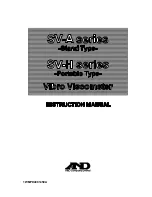
Section 7. Measurement Instructions
7-12
Calibrate
Measures offset and gain on all voltage ranges. This instruction is done
automatically at user program compile time. The major factor affecting the
calibration of the analog section is temperature. If calibration is not done as
part of the program, a typical shift in the calibration is 0.01 % per degree C
change from the temperature at which the program compile calibration
occurred. When there is adequate time for all measurements,
BiasComp
and
Calibrate
are typically run in a scan in the SlowSequence section of the
program to provide continuous adjusting of the calibration as temperature
changes. If executed in the SlowSequence, an RC filter is applied with the
previous calibration weighted .95 and the new weighted .05. Calibrate uses 54
measurement slots in the Task Sequencer.
BiasComp
Measures bias current and adjusts the bias current DACS accordingly. This
instruction is done automatically at user program compile time. The bias
current is the amount of current that is required to flow into the input channel
in order to make the measurement. This is reduced to a minimum (<3
nanoamps) when the bias current compensation is adjusted correctly. If the
bias current compensation is not adjusted correctly, the current could rise as
high as 100 nanoamps. The major factor affecting the bias current is
temperature. When there is adequate time for all measurements,
BiasComp
and
Calibrate
are typically run in a scan in the SlowSequence section of the
program to provide continuous adjusting of the bias current compensation and
the calibration as temperature changes. If executed in the SlowSequence, an
RC filter is applied with the previous bias compensation weighted .95 and the
new weighted .05. BiasComp uses 120 measurement slots in the task
sequencer.
The 4 DAC values that are the results of the bias compensation appear in the
Status Table: BiasLo, BiasLo X10, BiasHi, BiasHI X10.
7.7 Peripheral Devices
AM25T (AM25TChan, CardAnlg, ChanAnlg, CardPort, ClkPort, ResPort,
ChanExcite)
This Instruction controls the AM25T Multiplexer when used with the CR9000.
The AM25T instruction precedes the instruction used to make the
measurements on the AM25T, and must be inserted before any instruction that
makes a measurement on the AM25T. In the measurement that follows, the
CR9000 will automatically switch the AM25T so that all repetitions specified
in the measurement are made on AM25T channels. If RevDiff is specified in
the measurement, the CR9000 will reverse the input at the AM25T.
ModuleTemp can be used following the AM25T instruction (set for channel 0)
to measure the AM25T temperature.
Summary of Contents for CR9000
Page 6: ...CR9000 Table of Contents iv This is a blank page ...
Page 22: ...CR9000 Overview OV 16 This is a blank page ...
Page 26: ...Section 1 Installation 1 4 CR9000 FIGURE 1 1 3 CR9000 Battery Pack ...
Page 72: ...Section 3 CR9000 Measurement Details 3 28 This is a blank page ...
Page 88: ...Section 5 Program Declarations 5 6 This is a blank page ...
Page 217: ...This is a blank page ...
















































